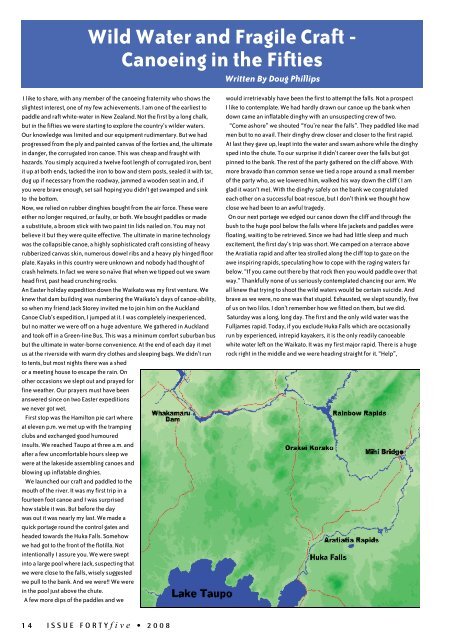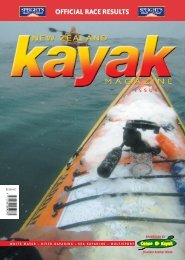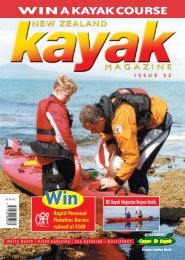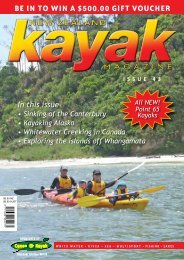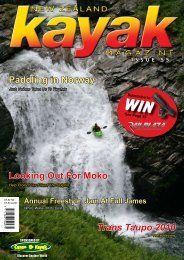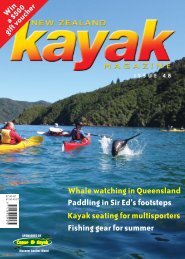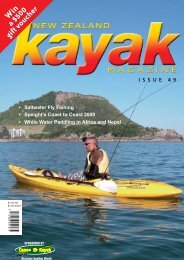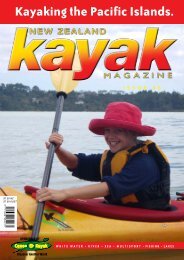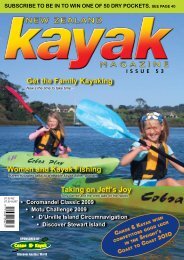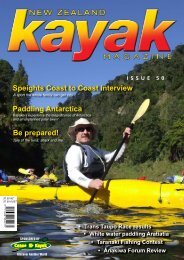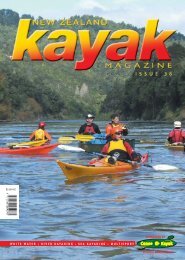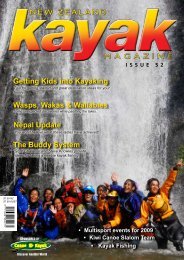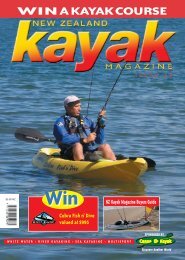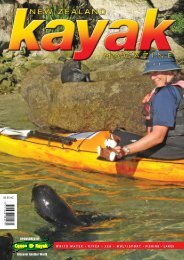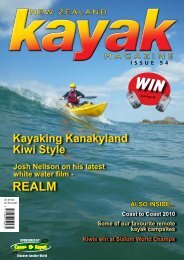ISSUE 4 5 Trans Taupo Race Results - Canoe & Kayak
ISSUE 4 5 Trans Taupo Race Results - Canoe & Kayak
ISSUE 4 5 Trans Taupo Race Results - Canoe & Kayak
- No tags were found...
Create successful ePaper yourself
Turn your PDF publications into a flip-book with our unique Google optimized e-Paper software.
Wild Water and Fragile Craft -<strong>Canoe</strong>ing in the FiftiesWritten By Doug PhillipsI like to share, with any member of the canoeing fraternity who shows theslightest interest, one of my few achievements. I am one of the earliest topaddle and raft white-water in New Zealand. Not the first by a long chalk,but in the fifties we were starting to explore the country’s wilder waters.Our knowledge was limited and our equipment rudimentary. But we hadprogressed from the ply and painted canvas of the forties and, the ultimatein danger, the corrugated iron canoe. This was cheap and fraught withhazards. You simply acquired a twelve foot length of corrugated iron, bentit up at both ends, tacked the iron to bow and stern posts, sealed it with tar,dug up if necessary from the roadway, jammed a wooden seat in and, ifyou were brave enough, set sail hoping you didn’t get swamped and sinkto the bottom.Now, we relied on rubber dinghies bought from the air force. These wereeither no longer required, or faulty, or both. We bought paddles or madea substitute, a broom stick with two paint tin lids nailed on. You may notbelieve it but they were quite effective. The ultimate in marine technologywas the collapsible canoe, a highly sophisticated craft consisting of heavyrubberized canvas skin, numerous dowel ribs and a heavy ply hinged floorplate. <strong>Kayak</strong>s in this country were unknown and nobody had thought ofcrash helmets. In fact we were so naïve that when we tipped out we swamhead first, past head crunching rocks.An Easter holiday expedition down the Waikato was my first venture. Weknew that dam building was numbering the Waikato’s days of canoe-ability,so when my friend Jack Storey invited me to join him on the Auckland<strong>Canoe</strong> Club’s expedition, I jumped at it. I was completely inexperienced,but no matter we were off on a huge adventure. We gathered in Aucklandand took off in a Green-line Bus. This was a minimum comfort suburban busbut the ultimate in water-borne convenience. At the end of each day it metus at the riverside with warm dry clothes and sleeping bags. We didn’t runto tents, but most nights there was a shedor a meeting house to escape the rain. Onother occasions we slept out and prayed forfine weather. Our prayers must have beenanswered since on two Easter expeditionswe never got wet.First stop was the Hamilton pie cart whereat eleven p.m. we met up with the trampingclubs and exchanged good humouredinsults. We reached <strong>Taupo</strong> at three a.m. andafter a few uncomfortable hours sleep wewere at the lakeside assembling canoes andblowing up inflatable dinghies.We launched our craft and paddled to themouth of the river. It was my first trip in afourteen foot canoe and I was surprisedhow stable it was. But before the daywas out it was nearly my last. We made aquick portage round the control gates andheaded towards the Huka Falls. Somehowwe had got to the front of the flotilla. Notintentionally I assure you. We were sweptinto a large pool where Jack, suspecting thatwe were close to the falls, wisely suggestedwe pull to the bank. And we were!! We werein the pool just above the chute.A few more dips of the paddles and wewould irretrievably have been the first to attempt the falls. Not a prospectI like to contemplate. We had hardly drawn our canoe up the bank whendown came an inflatable dinghy with an unsuspecting crew of two.“Come ashore” we shouted “You’re near the falls”. They paddled like madmen but to no avail. Their dinghy drew closer and closer to the first rapid.At last they gave up, leapt into the water and swam ashore while the dinghysped into the chute. To our surprise it didn’t career over the falls but gotpinned to the bank. The rest of the party gathered on the cliff above. Withmore bravado than common sense we tied a rope around a small memberof the party who, as we lowered him, walked his way down the cliff ( I amglad it wasn’t me). With the dinghy safely on the bank we congratulatedeach other on a successful boat rescue, but I don’t think we thought howclose we had been to an awful tragedy.On our next portage we edged our canoe down the cliff and through thebush to the huge pool below the falls where life jackets and paddles werefloating, waiting to be retrieved. Since we had had little sleep and muchexcitement, the first day’s trip was short. We camped on a terrace abovethe Aratiatia rapid and after tea strolled along the cliff top to gaze on theawe inspiring rapids, speculating how to cope with the raging waters farbelow. “If you came out there by that rock then you would paddle over thatway.” Thankfully none of us seriously contemplated chancing our arm. Weall knew that trying to shoot the wild waters would be certain suicide. Andbrave as we were, no one was that stupid. Exhausted, we slept soundly, fiveof us on two lilos. I don’t remember how we fitted on them, but we did.Saturday was a long, long day. The first and the only wild water was theFulljames rapid. Today, if you exclude Huka Falls which are occasionallyrun by experienced, intrepid kayakers, it is the only readily canoeablewhite water left on the Waikato. It was my first major rapid. There is a hugerock right in the middle and we were heading straight for it. “Help”,14 <strong>ISSUE</strong> FORTYfive • 2 0 0 8


